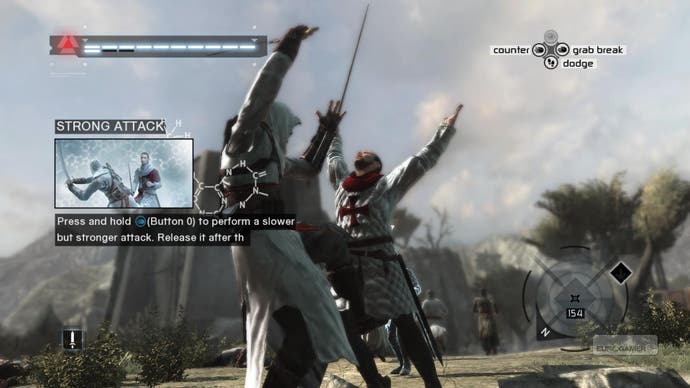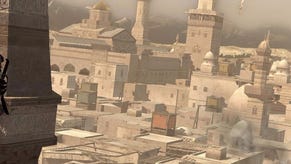Assassin's Creed retrospective
Altair of this joke eventually.
The Assassin's Creed games may be about exploring the genetic memories of Desmond Miles' ancestors, but you won't need a fancy Animus device to remember the series' first instalment. It came out just five years ago, and it's weird to think that it was as recently as the start of November 2007 that we had no idea about any of this. Since then, Assassin's Creed has become one of the biggest game series of its generation, and in Ezio Auditore - star of three games in the peculiar grouping that is 'the Assassin's Creed 2 trilogy' - it has come as close as anybody to creating this generation's equivalent of the classic gaming mascot. How fitting that Ezio had an uncle called Mario.
With the expanded trilogy just days from its end, however (reviews go live at 5pm GMT on Tuesday), it seems like a good opportunity to revisit the very first instalment, which told the tale not of Ezio but Altair, a disgraced assassin who must relearn the tenets of his order's creed in order to rise through its ranks and achieve enlightenment. At its core, it's a game about nine assassinations, each of which you prepare for in a few simple ways - eavesdropping, pickpocketing a courier to acquire information, meeting with an informant, etc - before working your way close to the target and stalking them until you can strike.
One of the things that's most interesting about the original Assassin's Creed is just how far Ubisoft Montreal was prepared to go to rationalise the concept of the Animus, the machine Desmond uses to experience the memories of his ancestor Altair, and how in some cases it really works in the game's favour. For instance, the buttons you use aren't just controls; they are part of an elaborate 'Marionette' system, where buttons correspond to limbs rather than actions. Missions aren't just levels in the game; they are memories, or fragments of memories, that contribute to greater 'synchronisation'.
Rather than impede the suspension of disbelief, decisions like these actually help you to empathise with the systemic make-up of the game world, to the extent that actual bugs can be written off as glitches in the Animus, and repetitious dialogue - such as the guards all saying, "You dirty thief, I'll have your hand for that," in a range of accents from city to city - are not evidence of budget limitation but the Animus normalising the experience for Desmond. It all feels ordered and logical. No wonder the Templars (Abstergo) built it.

The Assassin's Creed fiction has become so sprawling and labyrinthine in the last five years that the relative simplicity and the well-defined focus of the original game now feels refreshing, but of course it was a double-edged sword at the time. For whatever reason - pressure to finish the game, perhaps - the Animus approach ultimately backfired and gave critics (including myself) additional ammo to fire at it when it ran out of gameplay variety after a few hours. That's a shame, because it comes very close to working.
There was certainly little else wrong with the open world that the first game takes place in, and five years later the beauty of places like Masyaf (the smaller city home of the assassin order) and Damascus endures. Viewed from street level, they are bustling hives of activity, full of street vendors, washer folk, guards and thieves, all bickering and bartering, while viewed from the rooftops they are a sea of sun-baked mud bricks, wood beams and palm fronds. The latter Creed games won more plaudits for their cities, but it's worth remembering that Damascus, Jerusalem and Acre were always beautiful - they just lacked things to do. When the developers reacted to criticism by stocking Assassin's Creed 2 full of side missions and collectables, it transformed the series' critical destiny, and it probably would have done for the original game as well.
One thing the cities never lack, though, is ways to move around them. The networks of free-running and platform-jumping props at rooftop level are one of the game's least celebrated achievements, but the one you probably appreciate the most whether you realise it or not. An early race mission emphasises this, as Altair hops from beam to privy to crane to brick ledge to curtain wall and rarely breaks stride. You can do this virtually anywhere in the whole of the game's Middle East, and the visual language of the world is bravely restrained, so there are no flashing interactive ledges, a la Enslaved.
"The simple things reveal an elegance that hides in the quieter moments of this series and is enjoyable to revisit and properly pay attention to, rather than racing past on your way to the next icon."

One weakness is the internal conflict between low and high profile actions. The game often requires you to move swiftly, but it constantly feels as though you're having your sleeve tugged at by its more patient systems. Climbing a building is cautious and methodical, even when you're being pursued by many men, and the context-sensitive grabs and hops frequently send you off-course. The series still struggles with this today, and perhaps the designers have decided that it's unfixable; playing more recent instalments of the series, it's noticeable that discretion feels more like an occasional luxury rather than a core concept.
That's actually one of the more exciting things about going back to the first Assassin's Creed - this really could be a stealth game first and foremost if that's what you wanted from it. The low-profile actions like sitting on benches, or 'blend', where you walk amongst monks and scholars to evade detection, are hugely empowering. The iconic haystacks that allow Altair to vanish from sight completely, meanwhile, are almost unequalled among modern 'serious' video games for their simultaneous brilliance and silliness.
A truly stealthy assassination often feels impossible, as some slip will usually draw you into prolonged combat instead, but it's interesting to imagine how the series would have developed if missions like the one to take out Sibrand, who stalks the top deck of a ship in the Acre docks, had been the game's defining memories rather than the ones where players moaned about repetition and lack of side missions. Using daggers to silence guards at a distance and patience to hop across moored boats without straying into sight lines, you reach the side of the ship and creep over its exterior, using your instincts and Animus HUD elements to find a quiet moment to spend with your target.
Stealth kills - especially aerial assassinations - remain some of the series' best moments, a lot of which has to do with the decisive chiming sound that accompanies the brilliantly animated final thrust of Altair's hidden blade into a victim's throat. (By the way, if you ever meet someone who has that chime as the text message noise on their phone, you should probably be wary.) There's a strange mixture of viciousness and solemnity to a silent kill performed from the air that just doesn't come through when you strike in other contexts.
It's things like this - and not the repetitive block-and-counter, which so bothered me at the time - that stand out now I'm back in Assassin's Creed, and I think it's because the absence of all those distractions that we demanded and then embraced in the sequels allow the simple things to stand out. Those simple things reveal an elegance that hides in the quieter moments of this series and is enjoyable to revisit and properly pay attention to, rather than racing past on your way to the next icon. That first ascent to viewpoint, for example, which allows you to stare out over an entire city - it seems so blasé now, but it really isn't. Nor is the first time you reach the outskirts of Damascus on horseback.

The increasingly silly and complex science-fiction that frames the player's activities nowadays is also completely absent here, meaning that all you have to concentrate on is the philosophical conflict between Assassins and Templars rather than the ciphers and postcards-across-the-aeons Armageddon nonsense - and I think it's more interesting this way. In fact, if there's one thing that encapsulates the elegance that still protrudes from the first Assassin's Creed, then perhaps it's the original maxim of the assassin order itself: "Nothing is true. Everything is permitted."
Fittingly, it was Ezio who probably captured its meaning best, when he explained it to Sofia. "To say that nothing is true is to realise that the foundations of society are fragile, and that we must be the shepherds of our own civilisation," he said. "To say that everything is permitted is to understand that we are the architects of our actions, and that we must live with their consequences, whether glorious or tragic."
As you take down each of the Templar targets in Assassin's Creed, they use their dying breath to lecture you about the courage of your convictions. They will not reconsider their belief that the world needs order through subjugation, not peace through freedom, and they sometimes sound quite convincing. I really like the fact that this is what Assassin's Creed is about. This game that sells so many millions of copies, and fills classrooms full of kids who suddenly know everything about the Borgias, is about a philosophical debate written across the ages by people lurking in the shadows. It's one of the many flashes of elegance, ingenuity and bravery that make the game worth checking out again sometime, despite its flaws, and why you can see how it went on to sire such a fantastic dynasty.









